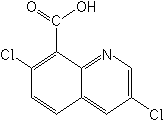Products >> Herbicides >> Quinclorac
Quinclorac
Quinclorac 95%TC
Quinclorac 50%WG
Quinclorac 50%SC
Quinclorac 25%SC
Herbicide
HRAC O, also L WSSA 4; quinolinecarboxylic acid

NOMENCLATURE
Common name quinclorac (BSI, draft E-ISO, (m) draft F-ISO)
IUPAC name 3,7-dichloroquinoline-8-carboxylic acid
Chemical Abstracts name 3,7-dichloro-8-quinolinecarboxylic acid
CAS RN [84087-01-4] EEC no. 402-780-1 Development codes BAS 514
H (BASF)
Quinclorac APPLICATIONS
Biochemistry Synthetic auxin (acting like indolylacetic acid); also
inhibitor of cell wall (cellulose) biosynthesis. Mode of action
Rapidly absorbed through the foliage. Weak auxin activity as determined
in wheat coleoptile elongation test, cucumber root elongation test,
cucumber curvature test and ethylene biosynthesis test in soya beans.
No influence on Hill reaction. Plant response is similar to IAA
or auxin-type herbicides of the class of benzoic acids and pyridine
compounds. Uses Pre- and post-emergence control of grass weeds (Echinochloa
spp., Aeschynomene spp., Sesbania spp.) and other weeds in direct-seeded
and transplanted rice, at 0.25-0.75 kg a.i./ha. Phytotoxicity Non-phytotoxic
to transplanted and direct-seeded rice. Under continuous irrigation
conditions, injury may occur in adjacent umbelliferous crops if
connected to the same waterway. Formulation types GR; SC; WP. Compatibility
Good combination partner for all rice herbicides which are insufficiently
effective against Echinochloa. Selected tradenames: 'Facet' (BASF);
'Queen' (Sanonda)
Quinclorac OTHER TRADENAMES
'Paramount' (BASF); 'Fas-Nox' (Crystal) mixtures: 'Cao Neng' (+
bensulfuron-methyl) (Anhui); 'Propacet' (+ propanil) (Crystal)
Quinclorac ANALYSIS
Product analysis by hplc. Residues in plant and animal matrices
by glc, in soil by hplc.
Quinclorac MAMMALIAN TOXICOLOGY
Oral Acute oral LD50 for rats 2680, mice >5000 mg/kg. Skin and
eye Acute percutaneous LD50 for rats >2000 mg/kg. Non-irritating
to eyes and skin (rabbits). Inhalation LC50 (4 h) for rats >5.2
mg/l. NOEL (2 y) for rats 533 mg/kg b.w. Other Not carcinogenic.
Toxicity class WHO (a.i.) III (Table 5); EPA (formulation) III EC
hazard Xi; R43
Quinclorac ECOTOXICOLOGY
Birds Acute oral LD50 for mallard ducks and quail >2000 mg/kg.
Dietary LD50 (8 d) for mallard ducks >5000 mg/kg. Fish LC50 (96
h) for rainbow trout, bluegill sunfish, carp, and minnows >100
mg/l. Daphnia LC50 (48 h) 113 mg/l. Other aquatic spp. LC50 (96
h) for mysid shrimp (Mysidopsis bahia) 67, blue crab >100 mg/l.
LC50 (48 h) for Quahog clam >100 mg/l. Bees Non-toxic by contact
or ingestion.
ENVIRONMENTAL FATE
Animals More than 90% of radiolabelled quinclorac administered orally
to rats is excreted in the urine within 5 days. Plants In plants,
systematically translocated to the roots and to the leaves. Soil/Environment
Only slightly adsorbed by the soil. Depending on soil type and organic
matter content, the chemical is relatively mobile, this mobility
increasing with higher percolation rates in fields. Quinclorac is
degraded by micro-organisms, 3-chloro-8-quinolinecarboxylic acid
being a major metabolite. Water regimes causing changes in moisture
content in rice soils enhance the microbial degradation. Photolytic
decomposition in active paddy water occurs in the presence of sunlight
and dissolved humic acids.